Cog VM at Google Code
Eliot's Cog VM for Squeak and Pharo now has a Google code project.
The author of this blog, James Robertson, passed away in April 2014. This blog is being maintained by David Buck (david@simberon.com).
Eliot's Cog VM for Squeak and Pharo now has a Google code project.
GNU Smalltalk 3.2.4 is out - download it here, and go visit the website for the details on what's new.
Technorati Tags: gst, gnu smalltalk
Google Summer of Code is a global program sponsored by Google that offers student developers stipends to write code for various open source software projects. The Smalltalk community has a successful record of participation in the scheme, under the aegis of ESUG in recent years, and our organisers are looking for students and ideas, (and even better, students with ideas) for our entry in this year’s programme.
Technorati Tags: esug
The conference is ending - Georg is sending us off with a few closing remarks. It was a fun conference, and I've recorded most of it on my H2 Zoom (I think the audio quality is fairly good). Additionally, STIC has been shooting video, although I have no idea how long it will take to get that online. I do know from experience that video editing is very time consuming :)
Good conference, and I hope to see people again next year!
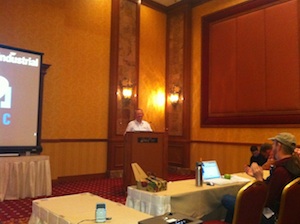
Last talk of the day and of the conference - Dorin Sandu is talking about integrating Lucene with Smalltalk, so that he didn't have to create his own search tools for the large amounts of data that he deals with on a regular basis.
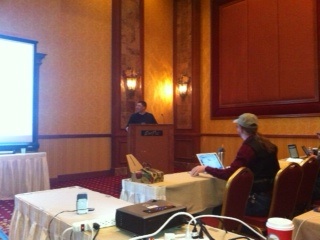
He wanted something small and fast, but also mature with a community to interact with - which is how he got to Lucene. Rather than reproduce the bullet points about Lucene, I'll send you to the website.
The demo is cool - he replaced the existing search facilities in BottomFeeder (which are pretty basic) with Lucene. The kinds of queries that Lucene supports are way, way better than the simple stuff I did :)
Technorati Tags: sts11, lucene, bottomfeeder, search
It's tag team time - Arden Thomas is talking about Polycephaly, and Andreas Hiltner is going to do a demo of using ObjectStudio. Here they are, getting started:
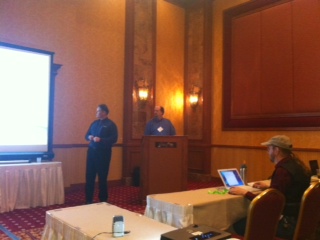
That first link above goes through what Polycephaly is - a way to use multiple Smalltalk images to take advantage of multi-core systems - I'm not going to go into detail here.
Update: Speaking of Polycephaly, Runar Jordahl has written up his experiences using it.
Technorati Tags: sts11, polycephaly, multi core
James Savidge works in Cincom support, and he's talking about ways to make your life easier when you need to debug problems that crop up. The first thing he did was a gentle - and funny - request for people to Read the Fine Manual :)
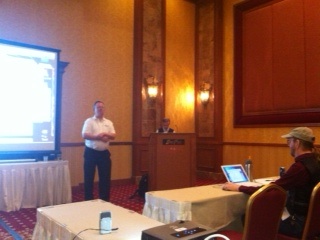
First tip: Remember the file browser, which can give you a quick view of either bytes or formatted source (depending on what you're looking at) of files. Next, he's going through the profiler (and the multi-allocation profiler), which a lot of people forget. I can attest to that - I don't know how many times I've been helping someone track a problem, and had them be surprised when I pulled out the profiler.
There's also the Memory Monitor (contributed), which can help quite a bit. It includes extensive logging facilities. Back when I was at Cincom, I covered this next bit pretty deeply in my screencasts - the various kinds of probes you can insert for information or debugging using the debugger.
Now a newer tool that I'm not familiar with - the benchmarking tool, which originated in ObjectStudio, but now also works in VW. Since it's a UI driven tool, it won't work headless.
Next, he's going over a tool that I've found to be very helpful - the logging for the various network protocols. When you don't know why your protocol requests are failing, this will let you see the traffic exchanges in detail.
As basic as it sounds, don't forget the Transcript (or the new #out message, which came from ObjectStudio). It's highly useful in server apps, because you'll typically toss the Transcript to a file. I've used that a lot.
Need to watch message sends - the Spy Tool (VW and OS) does that. It does not work in Web Velocity yet.
This next bit is something a lot of people are unaware of - command line options for the VM and image.
James is recommending my screencasts (the ones I did at Cincom). Those are still quite useful, but they aren't being updated now - so as time goes by and new releases of the Cincom products go out, they'll get more and more dated.
I missed the first 10 minutes or so of Martin McClure's talk - I suddenly developed a cough, and it looked like I was going to disturb his talk. So, I grabbed coffee while he started doing his demo. Here's Martin:
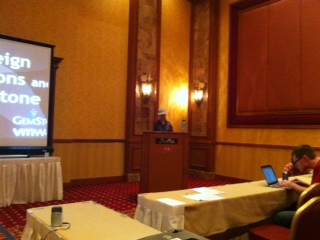
His first demo showed the way they used to do things (largely by hand), which worked, but was tedious. Now he's showing the newer, less ad-hoc code. It looks like they can parse a standard C header file, and extract out the available functions and create a wrapper class (an awful lot like DLLCC, but he's doing it from a workspace as opposed to a tool). One nice thing - you can filter to limit the plethora of things such a thing might try to wrap if you just let it go on its own.
What comes out of that is a wrapper class with a ton of Class Variables, each of which represents an interface to one of the generated functions. Absent the pragmas, the methods that get generated look a lot like what DLLCC generates in VW. One nice thing - the wrapper includes the segment of the header file that became the interface in question, so you can see how you ended up where you are. That makes it a bit easier to hack on things that it doesn't get quite right.
And of course, you can download their 64 bit work and try this stuff yourself.
Technorati Tags: gemstone, foreign functions, sts11
It's Wednesday morning, and MIke Hales is telling us about TeaTime - an efficient messaging system (implemented originally for Croquet) that he ported to VisualWorks for use in the application that he's working on. It sounds pretty cool - here's Mike:
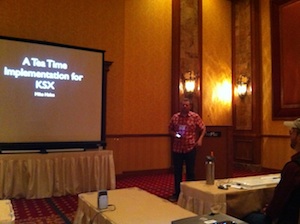
You can learn a lot more about TeaTime from the Wikipedia page for Croquet, which says the following:
TeaTime is a scalable real-time multi-user architecture that is the basis for Croquet's object-object communication and synchronization. It is designed to support multi-user applications that can be scaled to massive numbers of concurrently interacting users in a shared virtual space.
Patrick Barroca announced two additional themes for Pharo 1.2. You can download them from Squeaksource.
Technorati Tags: pharo
| Previous | Next | (1107 total) |